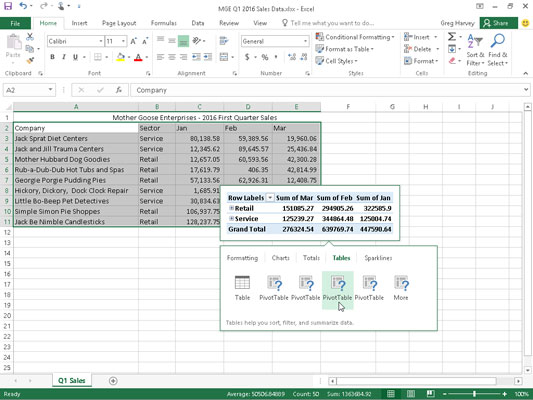Quick analysis tools in excel are the tools provided by Excel to quickly analyze any data rather than going the older method of inserting a chart or tables etc, there are two ways to see this quick analysis tools, select the cell range data which contains values and a yellow box appears on bottom right hand side which is the quick analysis tools or we can press CTRL + Q for quick analysis tools.
- Download Data Analysis Excel Mac
- Quick Analysis On Mac
- Quick Analysis Excel 2010
- Quick Analysis Tool In Excel 2019 For Mac
Download Data Analysis Excel Mac
- Analyzing large data sets with Excel makes work easier if you follow a few simple rules: Select the cells that contain the data you want to analyze. Click the Quick Analysis button image button that appears to the bottom right of your selected data (or press CRTL + Q). Selected data with Quick Analysis Lens button visible.
- Select a range of cells. Select the Quick Analysis button that appears at the bottom right corner of the selected data. Or, press Ctrl + Q.
- This has been a guide to Data Analysis ToolPak Add-in in Excel. Here we discuss the steps to load data Analysis Toolpak in Excel for tools like 1) Anova, 2) Correlation, 3) Rank and Percentile, 4) Descriptive Statistics along with practical examples, and a downloadable excel template. You may learn more about excel from the following articles –.
- The Analysis ToolPak is a Microsoft Office Excel add-in program that is available when you install Microsoft Office or Excel. To use it in Excel, however, you need to load it first. Under the File tab, under the Help heading, click on Options.
Excel’s Quick Analysis Tool is the easiest way to analyze your data instantly using different tools (Formatting, Charts, Totals, Tables or sparklines)
In today’s lesson, we will explain how to use this feature in Excel.
How to turn on the Quick Analysis feature?
You can choose two methods to activate the tool.
Go to Excel Option, on the General tab. Check Show Quick Analysis options on selection. From now the QAT toolbar will appear by default.
If you like using keyboard shortcuts, apply the Ctrl + Q combination.
Click the Quick Analysis button on the bottom-right corner of the range. The custom toolbar appears. You can choose from the following tools: Formatting, Charts, Totals, Tables, and sparklines.
Formatting Tables using Quick Analysis Tool
Now let us see how to apply conditional formatting using QAT. If you want to learn all about conditional formatting, we strongly recommend you our definitive guide.

The key differences between QAT and regular methods:
We get a quick live preview and select the option you want. The Quick Analysis Tools provides the most used functions:
- Data Bars, color-based highlighting, icons sets
- “Greater than” quick formulas
- Top N percentage
- Clean formatting rules
That is all we require! Let us assume that you prefer the common way to use all of the conditional formatting features. Go to the Home Tab and click on the ribbon.
Inserting charts using Quick Analysis Tool
Select the data range then click Charts on the floating toolbar. The button that appears at the bottom right corner of the selected range. Based on the type of selected data, you’ll see the most recommended chart types with previews.
If you want to choose another chart type, go to the Chart tab on the Ribbon. Select your preferred chart type and click it.
How to use Totals?

The Totals function is useful if you want to perform a quick analysis. Just pick one of the available options, and a new row will be inserted.
Tables
Tables play an important role in data analysis. Click on the Table icon to convert the current range into a table. If you have a larger initial data set, you can create Pivot tables too. Tables help you sort, filter and summarize data.
Sparklines
Sparklines are in-cell mini charts, and with their help, we can create a line, columns, and win / loss chart in single cells.
As the article suggests, today we will learn how to add Analysis ToolPak in Excel For Mac and Windows PCs. So let's get started.
The Analysis ToolPak is an add-on in Microsoft Excel. By default, this add-in is not installed in Excel.
Analysis toolPak of excel contains very helpful tools for statistical, financial, and engineering data analysis.
How to Add Analysis ToolPak to Excel 2016 in Windows?
To install the Analysis toolPak in Excel 2016 follow these steps.
- Click on file.
- Click on option. You’ll see the excel options dialogue box.
- Click on Add-Ins. It is on the left, second option from the bottom.
- Locate Analysis ToolPack and click on it.
- In the bottom, you must be able to see manage drop down. Select Excel-Add-ins and click on Go button.
- All available Add-ins will be shown to you. Select Analysis Toolpak and click OK.
Quick Analysis On Mac
Analysis ToolPak is added now. You can see it in the Data tab in the rightmost corner.
How to Add Analysis ToolPak in Excel 2016 for Mac?
To install Analysis toolpak in Excel for Mac, follow below steps.
- Goto tools or Insert menu.
- Locate Add-Ins and Click on it.
- You’ll be prompted to choose from available add-ins. Select Analysis Toolpak.
- Click Ok.
Analysis Toolpak is added. Goto data tab. In the rightmost corner you’ll find Analysis Toolpak waiting for you.
Analysis Toolpak has a number of useful statical tools that we will explore in our that we have explored in analysis tutorials.
Quick Analysis Excel 2010
The Analysis ToolPak in Excel 2010
Steps for a user to manually install Analysis ToolPak in Excel:
- Click on File ribbon
- Click on Options
Quick Analysis Tool In Excel 2019 For Mac
- From Options, select Add-Ins
- Select Analysis ToolPak and click on Go button
- You can see 4 Add-Ins options are available, check the Analysis ToolPak
- Click on OK button
- When you check Data ribbon, this time you will see Data Analysis option appears in Analysis Group.
- When you click on Data Analysis, you will find the dialog box as shown below:
There are a total of 19 options available in the Data Analysis:
1. Anova: Single Factor
2. Anova: Two-Factor with Replication
3. Anova: Two-Factor without Replication
4. Correlation
5. Covariance
6. Descriptive Statistics
7. Exponential Smoothing
8. F-Test Two Sample for Variance
9. Fourier Analysis
10. Histogram
11. Moving Average
12. Random Number Generation
13. Rank and Percentile
14. Regression
15. Sampling
16. t-Test: Paired Two Sample for Means
17. t-Test: Two-Sample Assuming Equal Variances
18. t-Test: Two-Sample Assuming Unequal Variances
19. Z-Test: Two-Samples for Mean
An add-in is simply a hidden tool that adds new features in Microsoft Excel 2010 and 2013.
Related Articles:
Popular Articles: